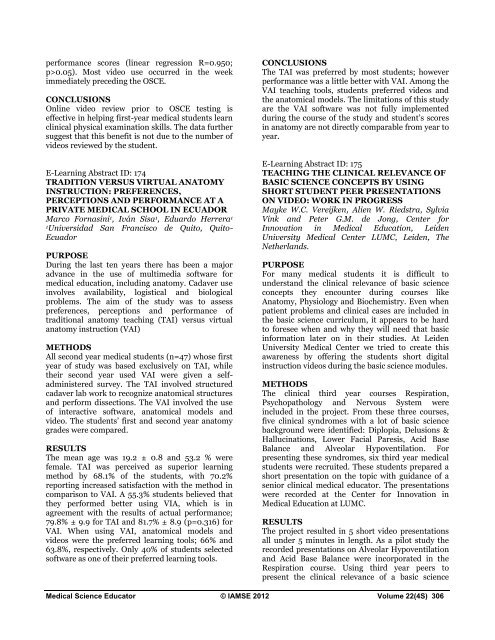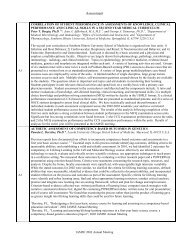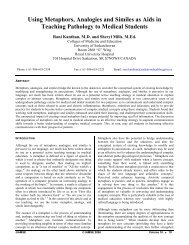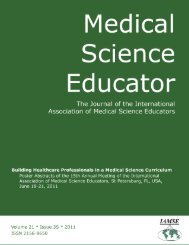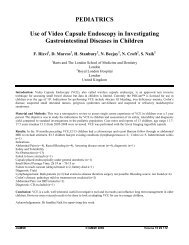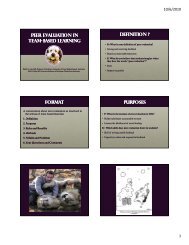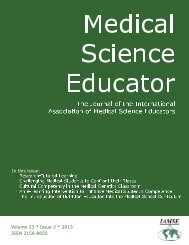Click here to view complete journal in pdf-format - IAMSE
Click here to view complete journal in pdf-format - IAMSE
Click here to view complete journal in pdf-format - IAMSE
Create successful ePaper yourself
Turn your PDF publications into a flip-book with our unique Google optimized e-Paper software.
performance scores (l<strong>in</strong>ear regression R=0.950;<br />
p>0.05). Most video use occurred <strong>in</strong> the week<br />
immediately preced<strong>in</strong>g the OSCE.<br />
CONCLUSIONS<br />
Onl<strong>in</strong>e video re<strong>view</strong> prior <strong>to</strong> OSCE test<strong>in</strong>g is<br />
effective <strong>in</strong> help<strong>in</strong>g first-year medical students learn<br />
cl<strong>in</strong>ical physical exam<strong>in</strong>ation skills. The data further<br />
suggest that this benefit is not due <strong>to</strong> the number of<br />
videos re<strong>view</strong>ed by the student.<br />
E-Learn<strong>in</strong>g Abstract ID: 174<br />
TRADITION VERSUS VIRTUAL ANATOMY<br />
INSTRUCTION: PREFERENCES,<br />
PERCEPTIONS AND PERFORMANCE AT A<br />
PRIVATE MEDICAL SCHOOL IN ECUADOR<br />
Marco Fornas<strong>in</strong>i 1 , Iván Sisa 1 , Eduardo Herrera 1<br />
1 Universidad San Francisco de Qui<strong>to</strong>, Qui<strong>to</strong>-<br />
Ecuador<br />
PURPOSE<br />
Dur<strong>in</strong>g the last ten years t<strong>here</strong> has been a major<br />
advance <strong>in</strong> the use of multimedia software for<br />
medical education, <strong>in</strong>clud<strong>in</strong>g ana<strong>to</strong>my. Cadaver use<br />
<strong>in</strong>volves availability, logistical and biological<br />
problems. The aim of the study was <strong>to</strong> assess<br />
preferences, perceptions and performance of<br />
traditional ana<strong>to</strong>my teach<strong>in</strong>g (TAI) versus virtual<br />
ana<strong>to</strong>my <strong>in</strong>struction (VAI)<br />
METHODS<br />
All second year medical students (n=47) whose first<br />
year of study was based exclusively on TAI, while<br />
their second year used VAI were given a selfadm<strong>in</strong>istered<br />
survey. The TAI <strong>in</strong>volved structured<br />
cadaver lab work <strong>to</strong> recognize ana<strong>to</strong>mical structures<br />
and perform dissections. The VAI <strong>in</strong>volved the use<br />
of <strong>in</strong>teractive software, ana<strong>to</strong>mical models and<br />
video. The students’ first and second year ana<strong>to</strong>my<br />
grades were compared.<br />
RESULTS<br />
The mean age was 19.2 ± 0.8 and 53.2 % were<br />
female. TAI was perceived as superior learn<strong>in</strong>g<br />
method by 68.1% of the students, with 70.2%<br />
report<strong>in</strong>g <strong>in</strong>creased satisfaction with the method <strong>in</strong><br />
comparison <strong>to</strong> VAI. A 55.3% students believed that<br />
they performed better us<strong>in</strong>g VIA, which is <strong>in</strong><br />
agreement with the results of actual performance;<br />
79.8% ± 9.9 for TAI and 81.7% ± 8.9 (p=0.316) for<br />
VAI. When us<strong>in</strong>g VAI, ana<strong>to</strong>mical models and<br />
videos were the preferred learn<strong>in</strong>g <strong>to</strong>ols; 66% and<br />
63.8%, respectively. Only 40% of students selected<br />
software as one of their preferred learn<strong>in</strong>g <strong>to</strong>ols.<br />
CONCLUSIONS<br />
The TAI was preferred by most students; however<br />
performance was a little better with VAI. Among the<br />
VAI teach<strong>in</strong>g <strong>to</strong>ols, students preferred videos and<br />
the ana<strong>to</strong>mical models. The limitations of this study<br />
are the VAI software was not fully implemented<br />
dur<strong>in</strong>g the course of the study and student’s scores<br />
<strong>in</strong> ana<strong>to</strong>my are not directly comparable from year <strong>to</strong><br />
year.<br />
E-Learn<strong>in</strong>g Abstract ID: 175<br />
TEACHING THE CLINICAL RELEVANCE OF<br />
BASIC SCIENCE CONCEPTS BY USING<br />
SHORT STUDENT PEER PRESENTATIONS<br />
ON VIDEO: WORK IN PROGRESS<br />
Mayke W.C. Vereijken, Alien W. Riedstra, Sylvia<br />
V<strong>in</strong>k and Peter G.M. de Jong, Center for<br />
Innovation <strong>in</strong> Medical Education, Leiden<br />
University Medical Center LUMC, Leiden, The<br />
Netherlands.<br />
PURPOSE<br />
For many medical students it is difficult <strong>to</strong><br />
understand the cl<strong>in</strong>ical relevance of basic science<br />
concepts they encounter dur<strong>in</strong>g courses like<br />
Ana<strong>to</strong>my, Physiology and Biochemistry. Even when<br />
patient problems and cl<strong>in</strong>ical cases are <strong>in</strong>cluded <strong>in</strong><br />
the basic science curriculum, it appears <strong>to</strong> be hard<br />
<strong>to</strong> foresee when and why they will need that basic<br />
<strong>in</strong><strong>format</strong>ion later on <strong>in</strong> their studies. At Leiden<br />
University Medical Center we tried <strong>to</strong> create this<br />
awareness by offer<strong>in</strong>g the students short digital<br />
<strong>in</strong>struction videos dur<strong>in</strong>g the basic science modules.<br />
METHODS<br />
The cl<strong>in</strong>ical third year courses Respiration,<br />
Psychopathology and Nervous System were<br />
<strong>in</strong>cluded <strong>in</strong> the project. From these three courses,<br />
five cl<strong>in</strong>ical syndromes with a lot of basic science<br />
background were identified: Diplopia, Delusions &<br />
Halluc<strong>in</strong>ations, Lower Facial Paresis, Acid Base<br />
Balance and Alveolar Hypoventilation. For<br />
present<strong>in</strong>g these syndromes, six third year medical<br />
students were recruited. These students prepared a<br />
short presentation on the <strong>to</strong>pic with guidance of a<br />
senior cl<strong>in</strong>ical medical educa<strong>to</strong>r. The presentations<br />
were recorded at the Center for Innovation <strong>in</strong><br />
Medical Education at LUMC.<br />
RESULTS<br />
The project resulted <strong>in</strong> 5 short video presentations<br />
all under 5 m<strong>in</strong>utes <strong>in</strong> length. As a pilot study the<br />
recorded presentations on Alveolar Hypoventilation<br />
and Acid Base Balance were <strong>in</strong>corporated <strong>in</strong> the<br />
Respiration course. Us<strong>in</strong>g third year peers <strong>to</strong><br />
present the cl<strong>in</strong>ical relevance of a basic science<br />
Medical Science Educa<strong>to</strong>r © <strong>IAMSE</strong> 2012 Volume 22(4S) 306


